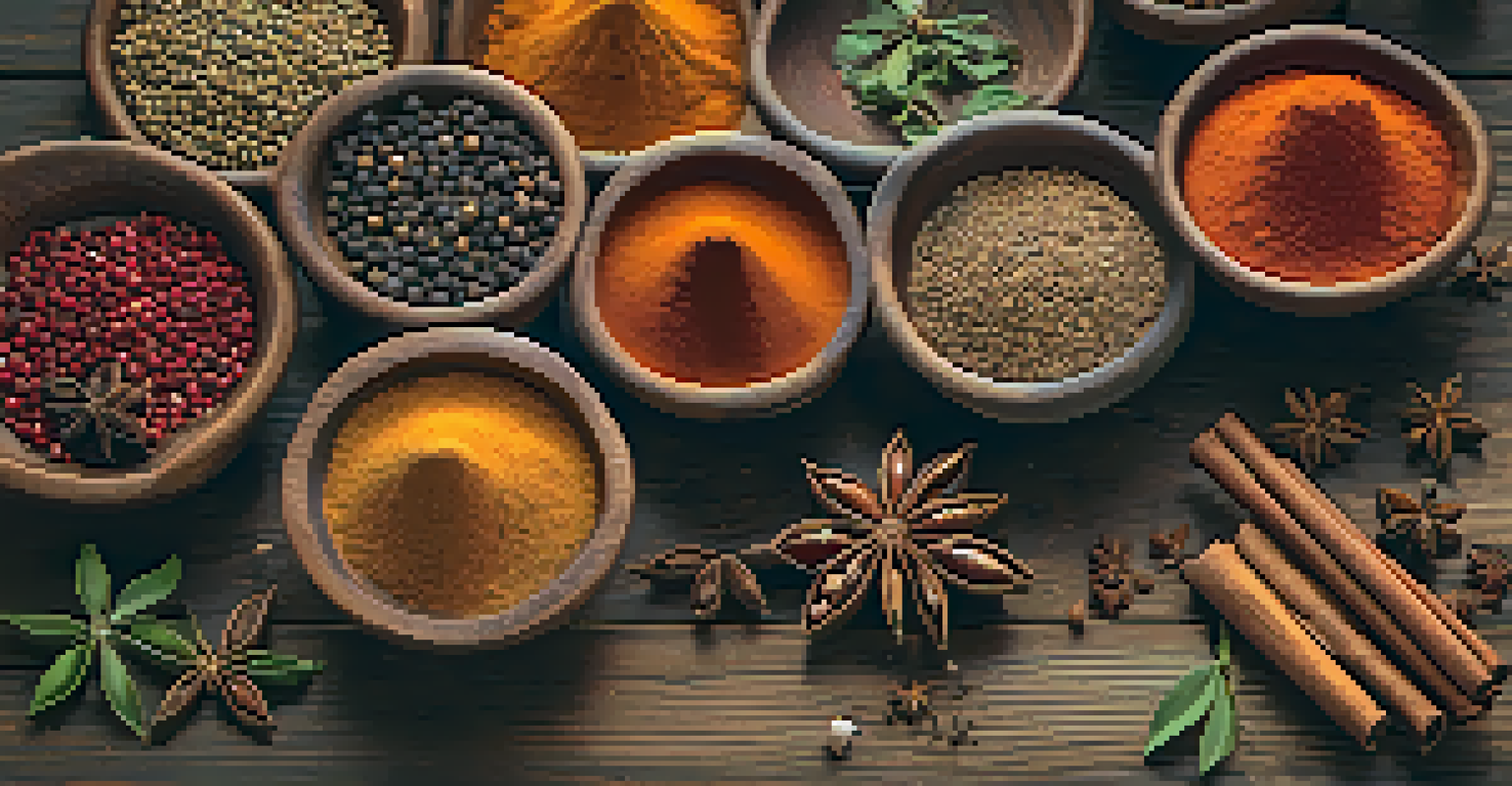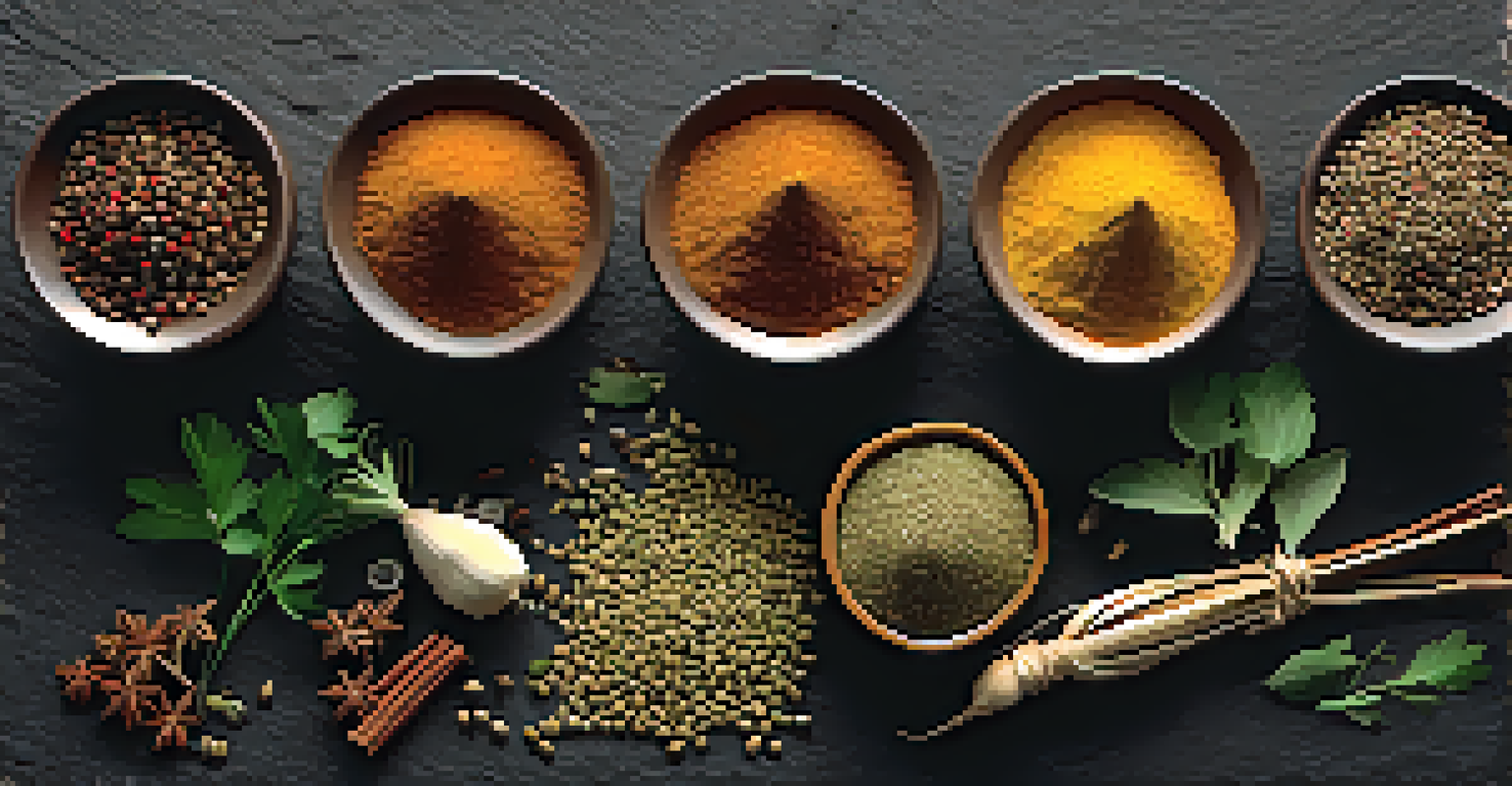Spices of the World: How They Shape Culinary Traditions

The Role of Spices in Global Cuisines
Spices have been integral to culinary practices across the globe, adding flavor, color, and aroma to our dishes. From the fiery heat of chili peppers in Mexican cuisine to the fragrant warmth of cinnamon in Middle Eastern dishes, spices define regional cooking styles. They are not just ingredients; they tell a story of culture, tradition, and history.
Spices are the ingredients that make food come alive, adding depth and character to every dish.
For instance, the use of saffron in Persian dishes highlights its luxurious status, while turmeric is a staple in Indian cooking for its earthy flavor and health benefits. Each spice has its own unique journey, often traveling thousands of miles to reach the kitchens where they are cherished. This reflects the interconnectedness of cultures and the global appreciation for diverse flavors.
Moreover, spices are key to preserving food, especially in hot climates where refrigeration is limited. Their antimicrobial properties have allowed civilizations to thrive by extending the shelf life of ingredients, making them indispensable throughout history.
The Historical Significance of Trade Routes
The quest for spices has shaped world history, leading to the establishment of trade routes that connected distant lands. The Spice Route, for example, was a network of maritime paths used by traders to transport valuable spices like nutmeg and cloves from the East Indies to Europe. This trade not only brought flavors to new regions but also facilitated cultural exchanges and the spread of ideas.

These routes were not without peril, often marked by conflicts and competition among nations eager to control the spice trade. The discovery of new lands, spurred by the desire for spices, led to the Age of Exploration, impacting global politics and economies in profound ways. It’s fascinating to think that the spices we enjoy today have such a rich and tumultuous backstory.
Spices Shape Global Cuisines
Spices not only enhance the flavor and aroma of dishes but also reflect the rich cultural heritage and history of the regions they come from.
Today, many spices still carry the weight of their historical significance, with some regions maintaining their traditional methods of cultivation and trade. This enduring legacy reminds us that each spice is a link to the past, enriching our culinary experiences in the present.
Regional Spices and Their Unique Flavors
Each region of the world boasts its own signature spices that enhance its culinary identity. For example, the vibrant blend of spices used in Indian cuisine, such as cumin, coriander, and garam masala, creates a rich tapestry of flavors that is both aromatic and complex. This diversity is what makes exploring international cuisines so exciting.
The discovery of new spices has changed the course of history and the way we cook, enriching our lives with flavors from around the globe.
In contrast, the subtle flavors of Mediterranean spices like oregano and thyme reflect the fresh, light nature of the dishes in that region. These spices complement ingredients such as olive oil and seafood, creating a harmonious balance that is both satisfying and refreshing. The way spices interact with local ingredients often defines the essence of a cuisine.
Furthermore, the use of spices can also vary within countries, with local traditions influencing how they are used in cooking. For instance, the smoky flavor of paprika in Spanish dishes contrasts sharply with the sweet and pungent notes of allspice in Jamaican cuisine, showcasing the regional diversity that spices can offer.
Spices as Symbols of Culture and Identity
Spices often carry cultural significance, representing heritage and identity for many communities. In many cultures, the act of cooking with specific spices is a way to honor traditions and pass down family recipes through generations. For example, in Thai cuisine, the use of lemongrass and galangal not only adds flavor but also reflects the country's culinary heritage.
Additionally, festivals and celebrations around the world often feature traditional dishes that highlight the use of specific spices. From the use of cardamom in Indian sweets during Diwali to cinnamon in baked goods during Christmas in various cultures, spices play a central role in festive gatherings. These culinary practices create a sense of belonging and connection among individuals.
Trade Routes and Cultural Exchange
The pursuit of spices has historically driven trade routes, fostering cultural exchanges and significantly impacting global politics and economies.
The significance of spices extends beyond the kitchen; they can be a source of pride and identity for entire nations. For instance, the distinct flavors of Ethiopian cuisine, characterized by spices like berbere, serve as a representation of the country’s rich history and cultural diversity.
Spices and Health Benefits: A Culinary Powerhouse
Beyond their flavor-enhancing qualities, many spices are packed with health benefits that have been recognized for centuries. Turmeric, for example, contains curcumin, a compound known for its anti-inflammatory properties, making it a staple in traditional medicine practices. Incorporating these spices into our diets not only elevates our meals but also contributes to our overall well-being.
Garlic is another spice celebrated for its health benefits, known to boost the immune system and promote heart health. Its pungent flavor enhances countless dishes, from Italian pastas to Asian stir-fries, proving that eating healthy can also be delicious. This intersection of health and flavor is a wonderful aspect of culinary traditions worldwide.
Moreover, the continued research into the medicinal properties of spices only adds to their allure in modern cooking. As people become more health-conscious, the challenge lies in balancing flavor with nutrition, and spices provide the perfect solution to this culinary conundrum.
Sustainable Sourcing of Spices
As the demand for spices grows, so does the need for sustainable sourcing practices. Many spice-producing regions face challenges such as over-farming, climate change, and economic pressures that threaten their unique ecosystems. By prioritizing sustainability, we can ensure that future generations continue to enjoy the rich flavors and benefits that spices offer.
Farmers are increasingly adopting organic practices and ethical sourcing methods to meet consumer demand for sustainable products. This not only helps preserve biodiversity but also supports local economies and communities reliant on spice production. For example, fair-trade certifications ensure that farmers receive a fair price for their crops, promoting better living conditions.
Health Benefits of Spices
Many spices offer notable health benefits, blending flavor with nutrition and contributing to overall well-being.
Consumers play a crucial role as well; by choosing sustainably sourced spices, we can make informed decisions that positively impact the planet. The shift towards sustainability in spice production reflects a broader trend in the food industry, where the emphasis on ethical practices is becoming increasingly important.
The Future of Spices in Culinary Traditions
As we look to the future, spices will undoubtedly continue to shape culinary traditions around the world. With the rise of global cuisine and fusion cooking, new spice combinations are emerging, creating innovative flavors that excite the palate. This evolution reflects our ever-changing tastes and the blending of cultural influences.
Moreover, the increasing interest in plant-based diets has led to a renewed focus on spices as a way to enhance flavor without relying on animal products. For instance, spices like smoked paprika and nutritional yeast are being used to create depth and richness in vegetarian and vegan dishes, demonstrating their versatility.

Ultimately, the future of spices in culinary traditions holds endless possibilities. As we embrace new trends and ideas, spices will remain at the heart of our kitchens, connecting us to our past while inspiring our culinary adventures ahead.